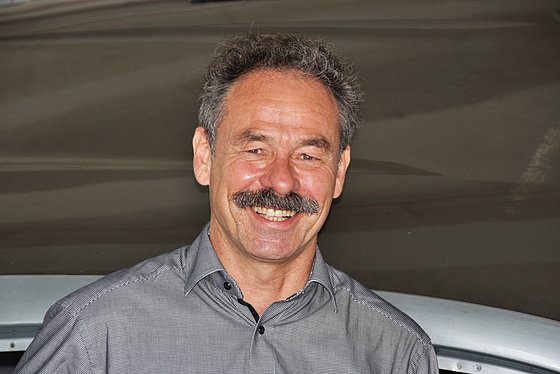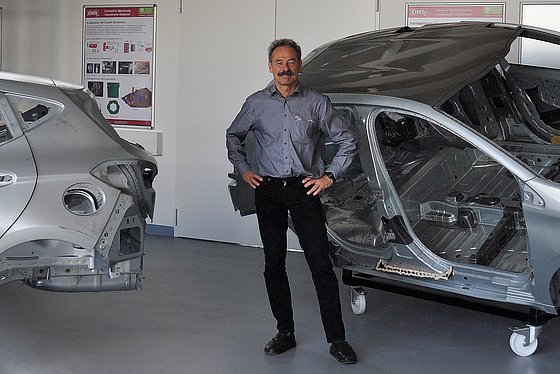
We build our own software
The Chair for Optimisation of Mechanical Structures in Wuppertal develops computer programs to support the automotive industry on its way into a new age of mobility
"For me, it is first of all important to know what I need for research, and that is curiosity!" Prof. Dr.-Ing. Axel Schumacher says. He is the chairholder of the Chair of Optimisation of Mechanical Structures in the Faculty of Mechanical Engineering and Safety Engineering at the University of Wuppertal. This basic requirement that research needs, wanting to know how things develop, does not need any practical experience initially, but often leads to not really realising how relevant results could be. After completing an apprenticeship, the trained machinist studied mechanical engineering in Duisburg and Aachen and worked for several years as a project manager at Opel. Therefore, he knows the corporate structures of large car manufacturers only too well and knows that research must deliver results. "It is particularly important in mechanical engineering that what I do technically can be implemented at some point," he explains, "we load computers with a huge amount of work, and it is absolutely essential that our results can be used." At this point, his own practical experience in interpersonal contact with business partners comes in handy. Through these contacts, he learns about the needs that then enable him to make a better assessment. "I know about the possibilities and I also know about the constraints they have. There are a lot of good technical discussions and these then have a positive impact on our research."
At his chair, Schumacher works with eight research assistants and seven additional doctoral students who have their jobs in companies or other research institutions. "The doctoral students have all approached us to do their doctorates in the field of optimising mechanical structures. That is quite a development for a relatively small subject," he says. Schumacher got one and a half full-time positions ascribed and finances the rest of his team through third-party funding, which he receives from industry and public sponsors.
Reduction of CO₂ emissions through lightweight construction
Schumacher's research focuses include the lightweight construction of automobiles. With the aim of reducing CO₂ emissions, optimised lightweight designs can make a decisive contribution to this if the results are extrapolated worldwide. "When we drive a car, the vehicle has several renitencies. A driving renitency in the sense of acceleration, in the sense of gradient, friction and air renitency," he explains. Apart from air renitency, all the other renitencies depend on the mass and if you reduce the mass, the renitencies also reduce. "If we save 100 kilograms on the vehicle, we can reduce 8.4 grams of CO₂ per vehicle," the scientist says, and that happens mainly on the body of the vehicle. "We call this a lightweight spiral and it works like this: If I have a lighter body, then I can install a lighter engine. This way I reduce the engine size and can save weight and also load for brakes and drive shafts. All these forces that the body has to bear are reduced and the spiral goes down. Even if you do not get to 100 kilograms directly, you save five kilos in one place and four kilos in another. And so you reduce weight bit by bit. The long-term effects can be better understood by the layman if the CO₂ emissions are calculated for all 58.2 million cars registered in Germany, whereby Schumacher emphasises: "The Germans produce worldwide, i.e. Germany is only a small playground as far as cars are concerned. If we do something for VW here, it has a global impact."
Optimisation algorithms find new shapes through biological growth rules
It is hard to believe, but the optimisation of mechanical structures also makes use of findings from biology. "We find shapes with mathematical optimisation algorithms," Schumacher reports, "we define what we want and do it based on simulations of the mechanical properties. There are different approaches. One possibility is biological evolution, which we map in the computer." Generated mutations are selected in biology. He and his team map this process in the computer. This kind of optimisation has been around since the 1970s and Schumacher uses the findings to develop it further. To do this, he uses knowledge that has been found out about trees and bones. "We look at the geometric growth rules. How does a bone grow? How does a tree grow? And you can programme this into shape optimisation." Material is always added at the points where a tree or a bone is particularly strained. A tree, for example, fills up an afflicted notch relatively quickly. Human bones also build up material when they are subjected to the respective strain. "When we go to the gym, we build muscle, but we also build bone in the places we need it. And we have that programmed in." The change in the structure then takes place in the computer in complex time steps, so that for cost reasons these processes are only worthwhile for components in large quantities. Unfortunately, there are only very few companies in the Bergisch Land that carry out simulations of mechanical properties. "In the Bergisch region, the companies have the manufacturing know-how. They know how to build something like this, but in the future they should also develop the component properties. They can learn that from us."

Generative Design
"You can also generate completely new concepts with optimisation methods," Schumacher says, "we call that 'generative design'. And the term we use here is topology optimisation." A kind of design concept is created by determining the optimal position and arrangement of structural elements. To do this, he says, the computer is given a few basic conditions, such as installation space, load and desired properties, and then proposes its own concepts. "It gets really exciting when our computer algorithms suggest concepts that I would not have thought of at first, but which turn out to be excellently suited in retrospect," he says enthusiastically. Schumacher cites a load on a crane as an example. The task for the computer was to find a solution by which the load line always remains exactly in the same place, i.e. neither drifts to the left nor to the right. The programme was finally able to determine the exact balancing in such a way that it could be applied to the construction.
Multidisciplinary optimisation of vehicles
For Schumacher, close cooperation with other engineering disciplines also means taking on responsibility. His colleagues are no longer mere suppliers, but bearers of responsibility. In the project 'Multidisciplinary Optimisation of Vehicles', the focus is on crash, acoustic, driving and static properties and strength. "We have a great algorithm where we take the individual disciplines into responsibility, so to speak. To do this, we have built a matrix in which each discipline knows, what it means for the other disciplines if they change something. So they, themselves, think interdisciplinary."
We build our own software
Digitalisation is advancing in leaps and bounds. The software, which Schumacher creates himself with his team for programmes is subject to constant renewal. "The rapidly changing software does not change by itself. We do that! We change it," he firmly says. "We build our own software."
Schumacher and his team are using the optimisation software GHT (graph and heuristics-based topology optimisation) in a new research project on the optimisation of 3D crash structures. It was developed at the Chair, and is used to optimise profile cross-sections of crash elements, which are, for example, the vehicle sill for the side crash. "This method combines mathematical optimisation algorithms with rules derived from expert knowledge, the heuristics. These heuristics are used in the automatic optimisation process to successively generate layout proposals that are shape-optimised using the mathematical algorithms." All of this is very complicated, which is why his Wuppertal Chair enjoys a unique position worldwide, because most optimisers do not even dare to tackle these challenges.
Schumacher's biographical advantage lies on the one hand in his experience of crash calculation in the private sector, and on the other hand in his doctorate on the subject of optimisation. Both together and the rethinking of the car industry in favour of e-mobility make his project a real hit. "The process is in great demand in the automotive industry. Especially because the alternative drives are creating new, completely different vehicle concepts. That is where our process is helping a lot right now. There are vehicles already on the road that contain structures generated with our process." He cites VW's electric vehicles as an example. There is a cooperation agreement with the car manufacturer, but it also allows cooperation with other research institutes or software companies. The upheaval in the vehicle industry favours the development of his method. "New concepts are needed and we know how they should do it. With our process, we provide the first ideas on how to build something like this."
Curiosity, Axel Schumacher said at the beginning, is what is needed for research. On the way to a new age of mobility, this also applies to the economy.
Uwe Blass (Interview on March 24, 2021)
Prof. Dr. Ing. Axel Schumacher studied Mechanical Engineering in Duisburg and Aachen. From 2003 - 2012 he taught as a professor at the Hamburg University of Applied Sciences, Department of Automotive Engineering and Aircraft Construction. Since 2012, he has held the Chair for Optimisation of Mechanical Structures in the Faculty of Mechanical Engineering and Safety Engineering at the University of Wuppertal.
